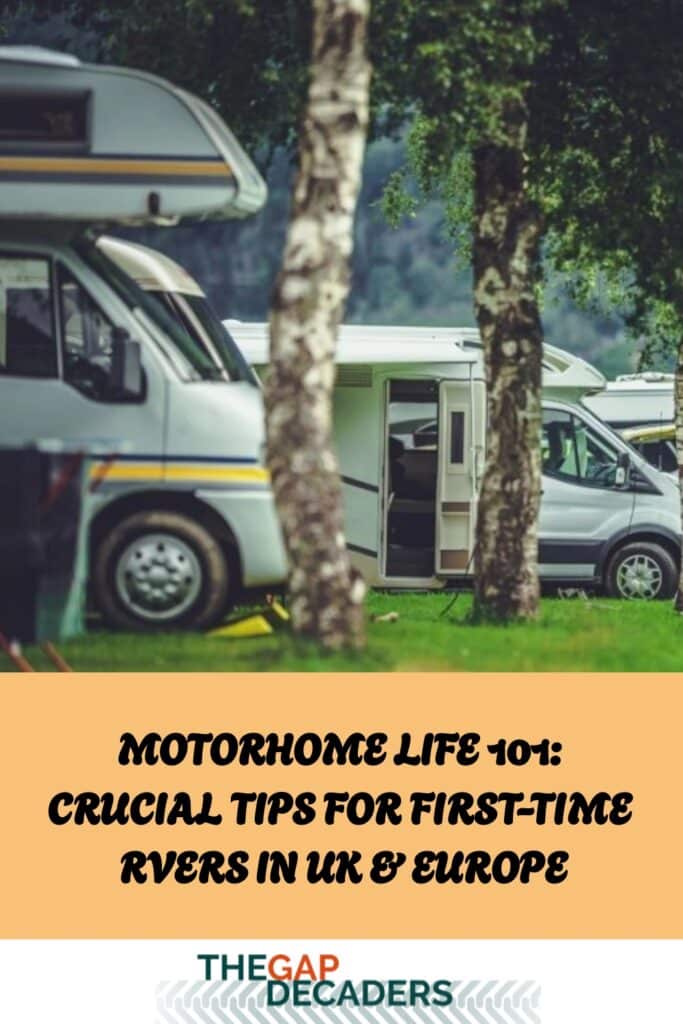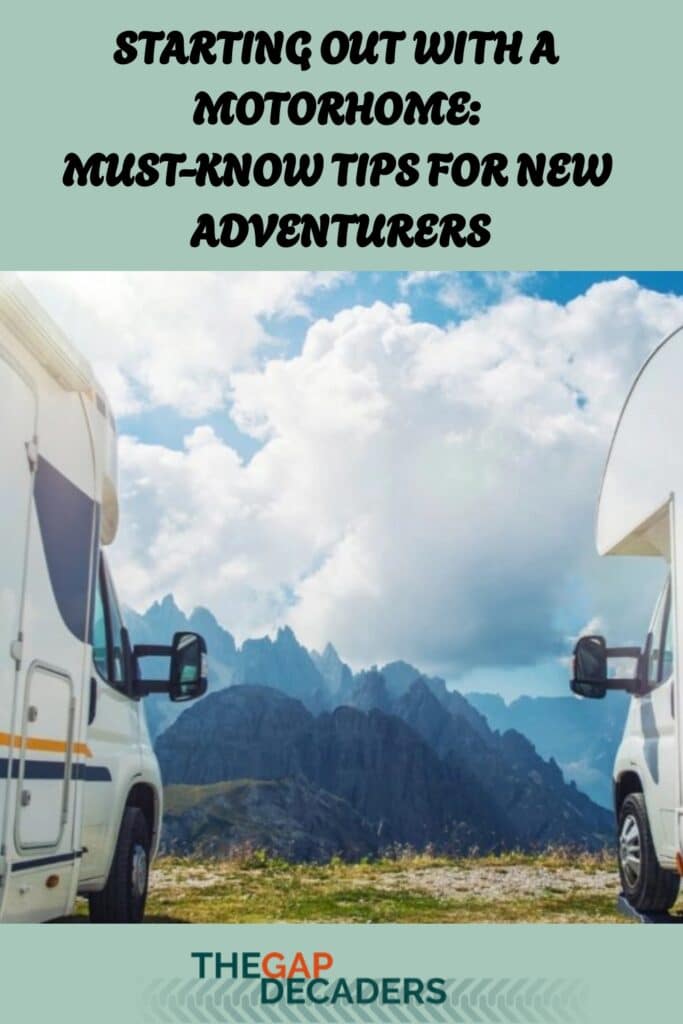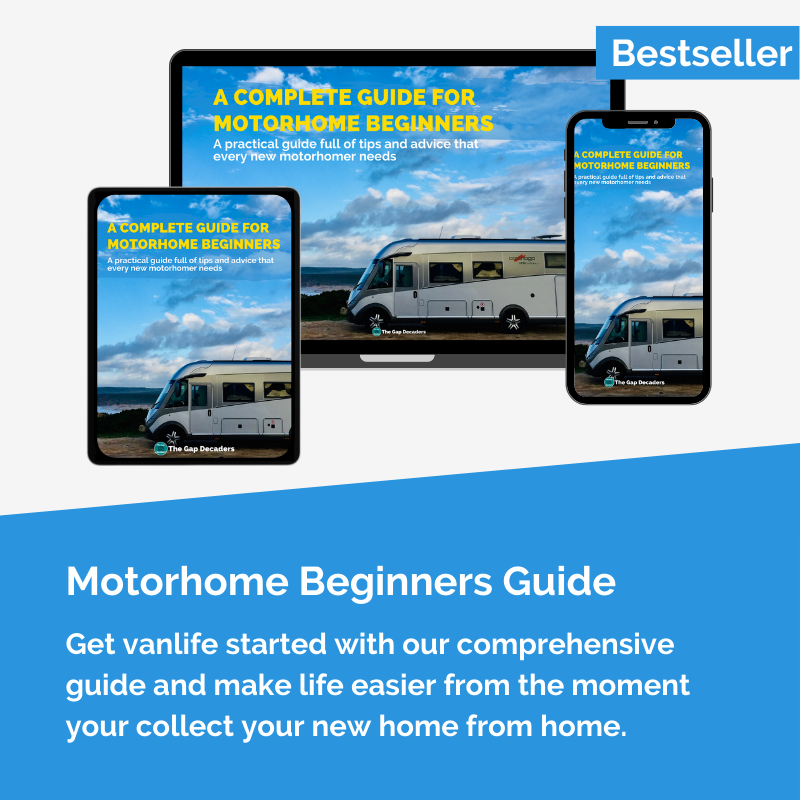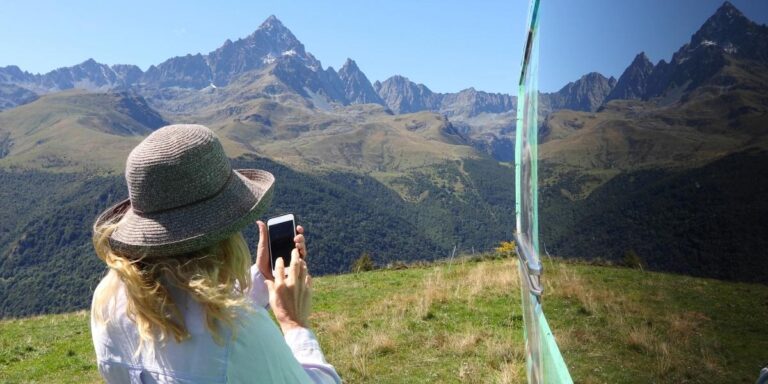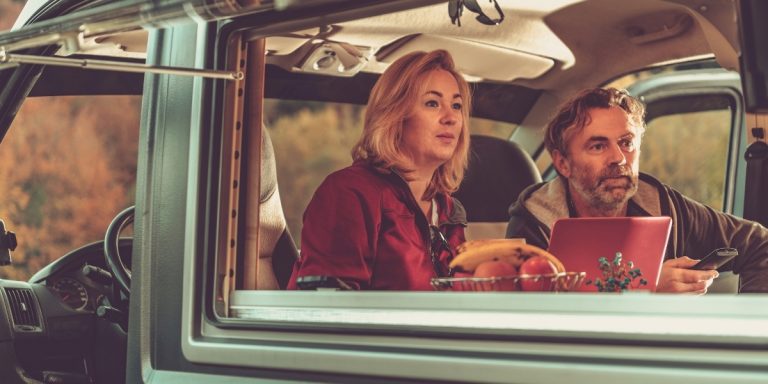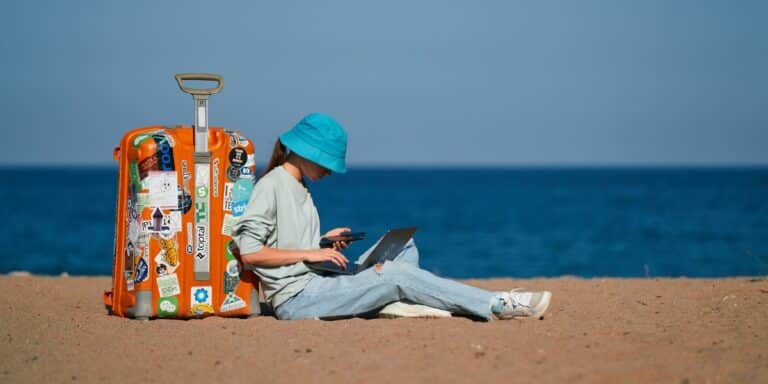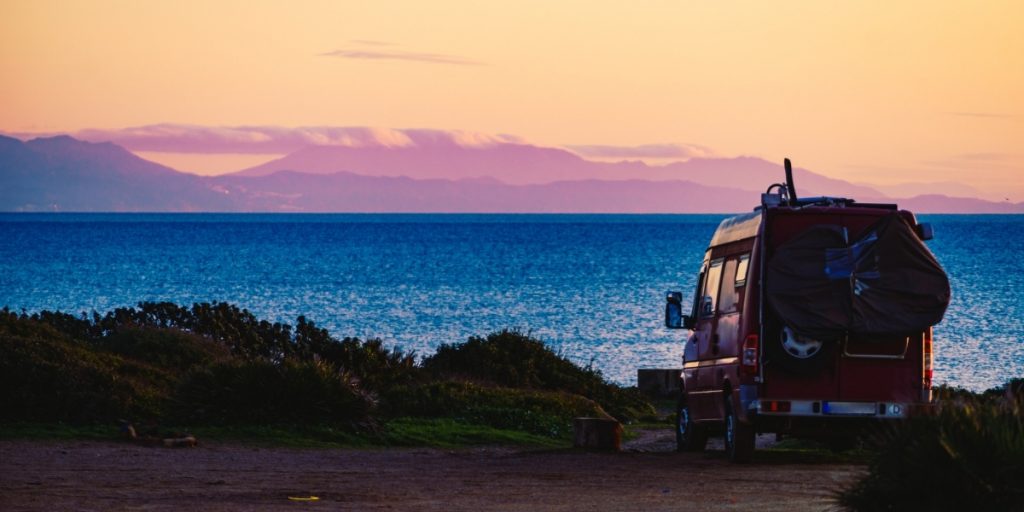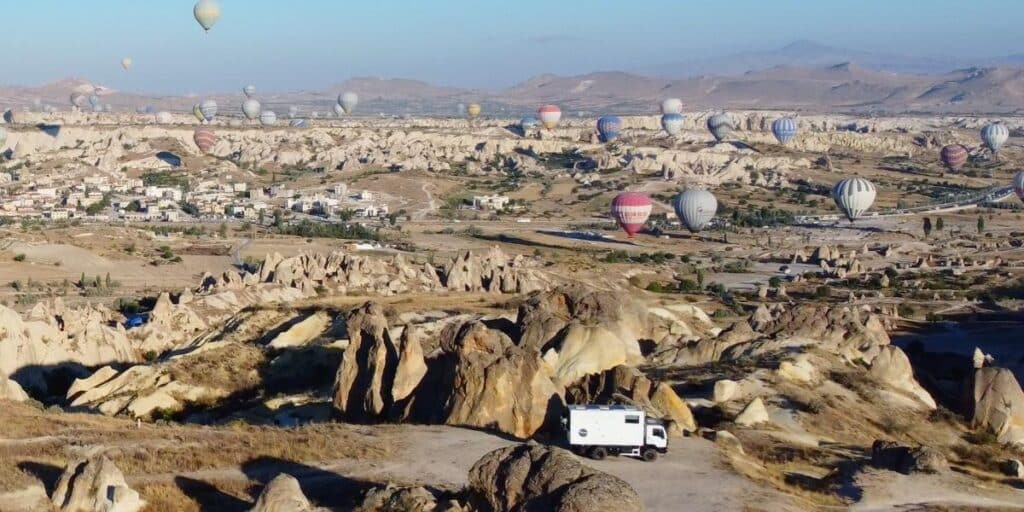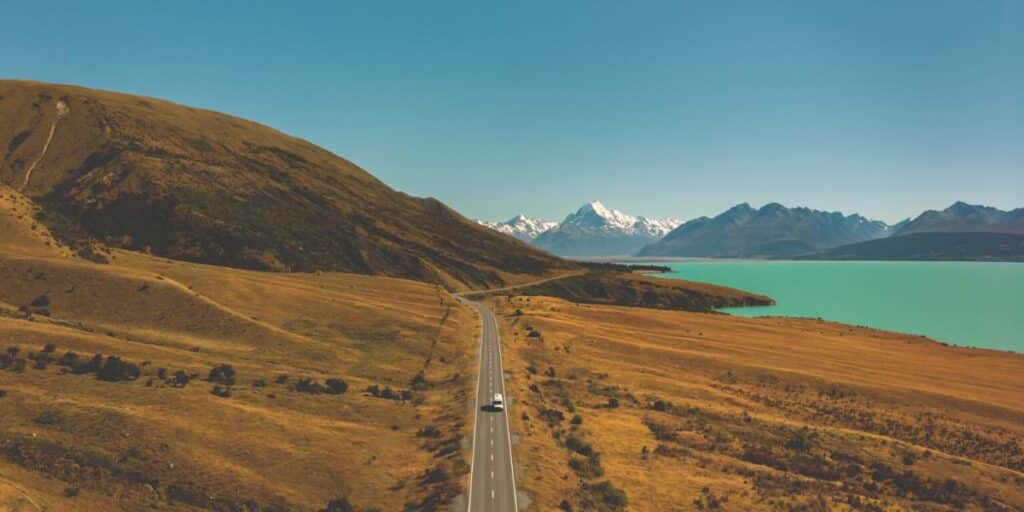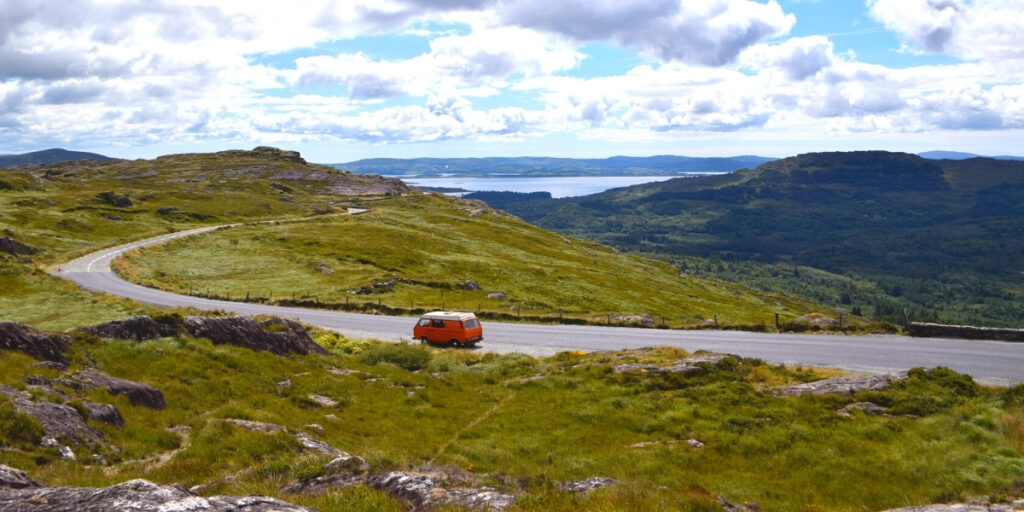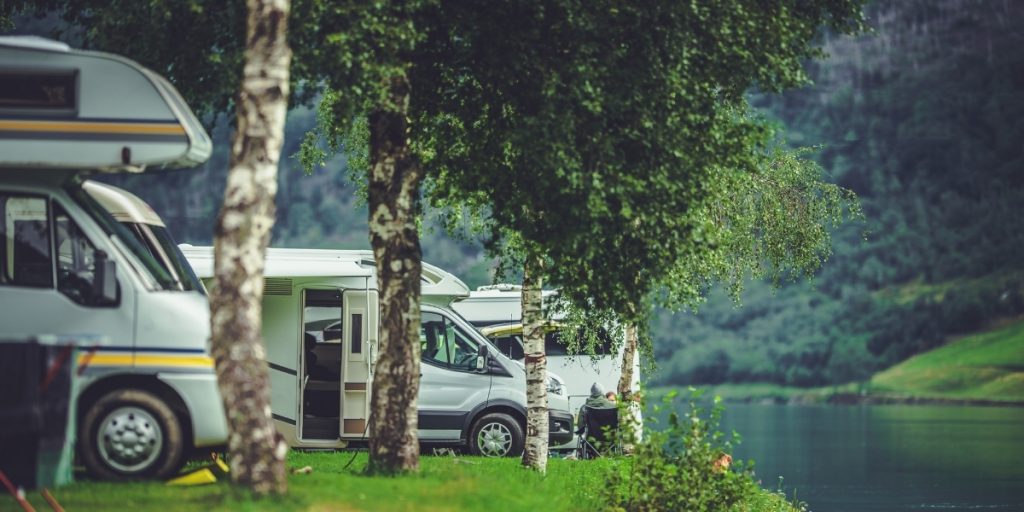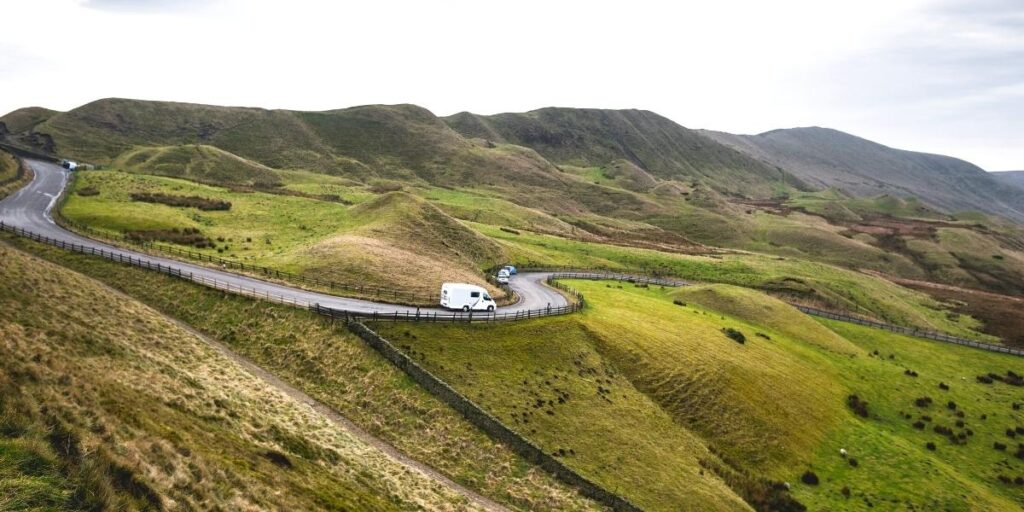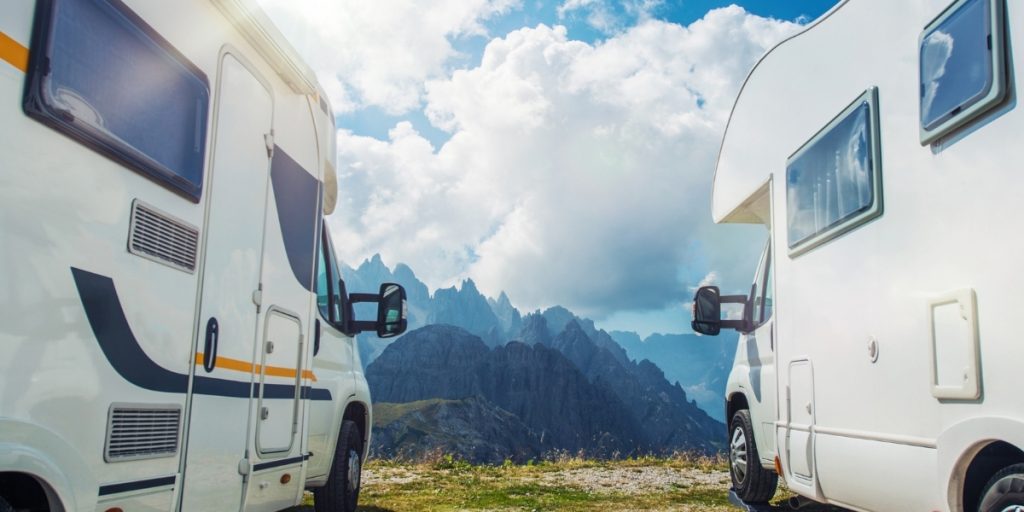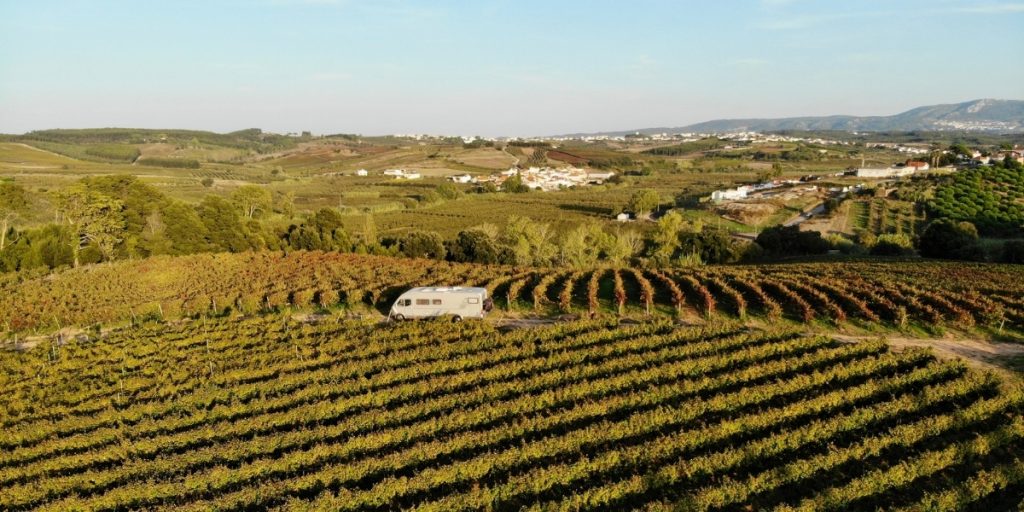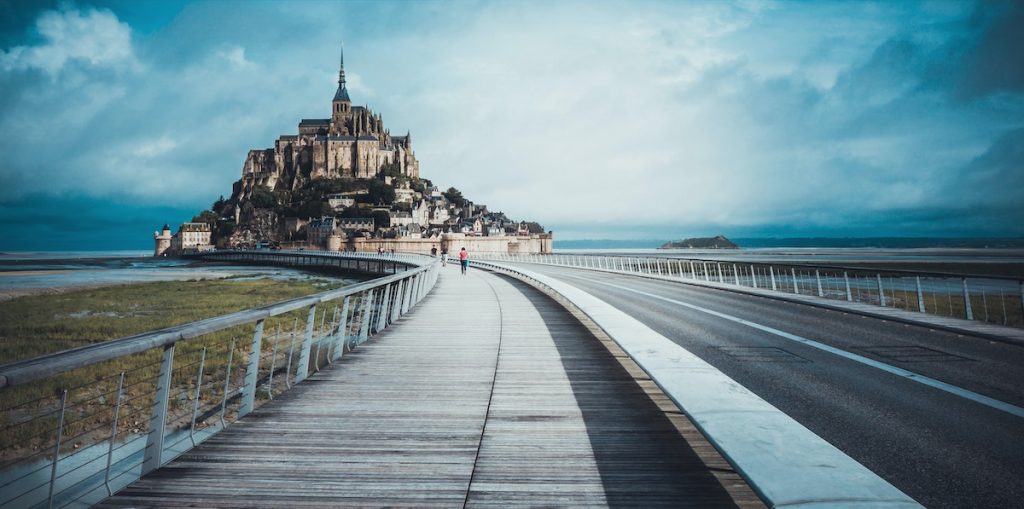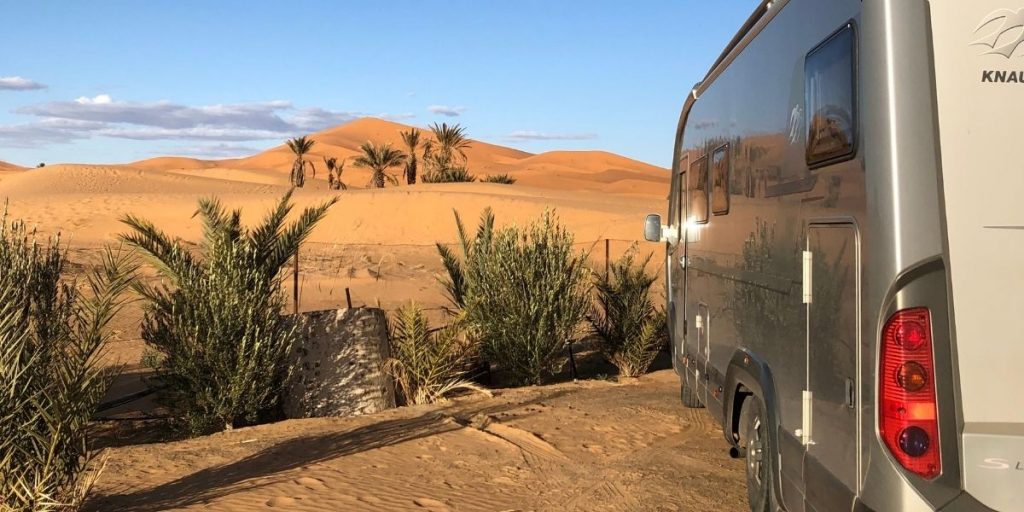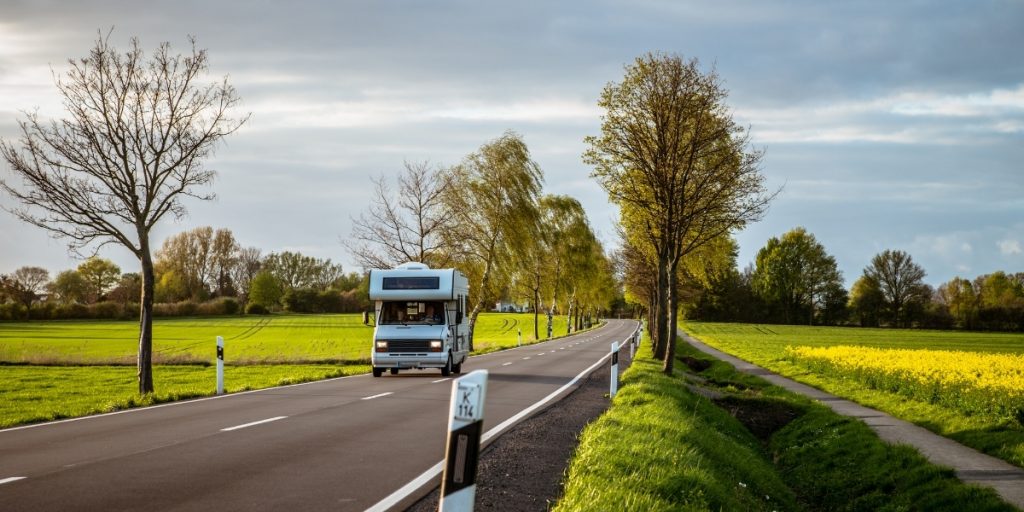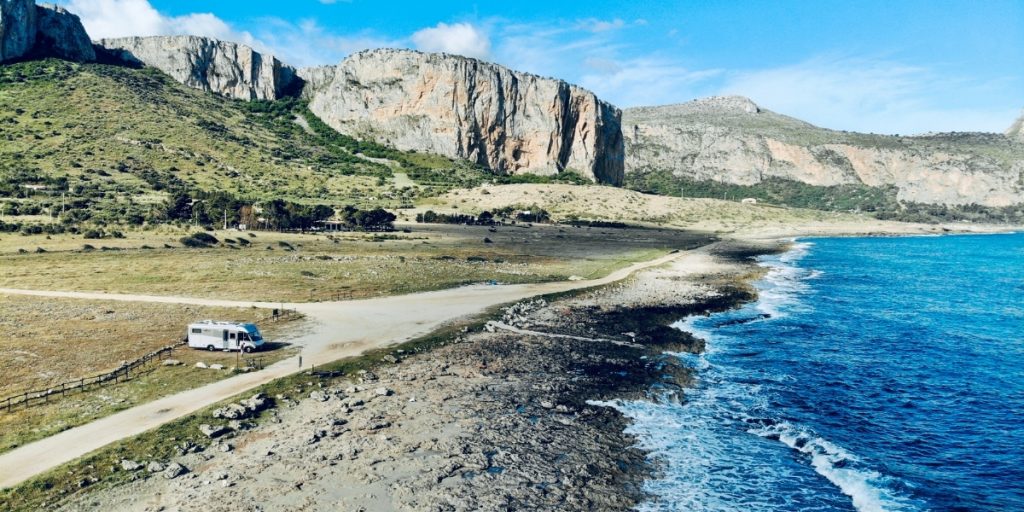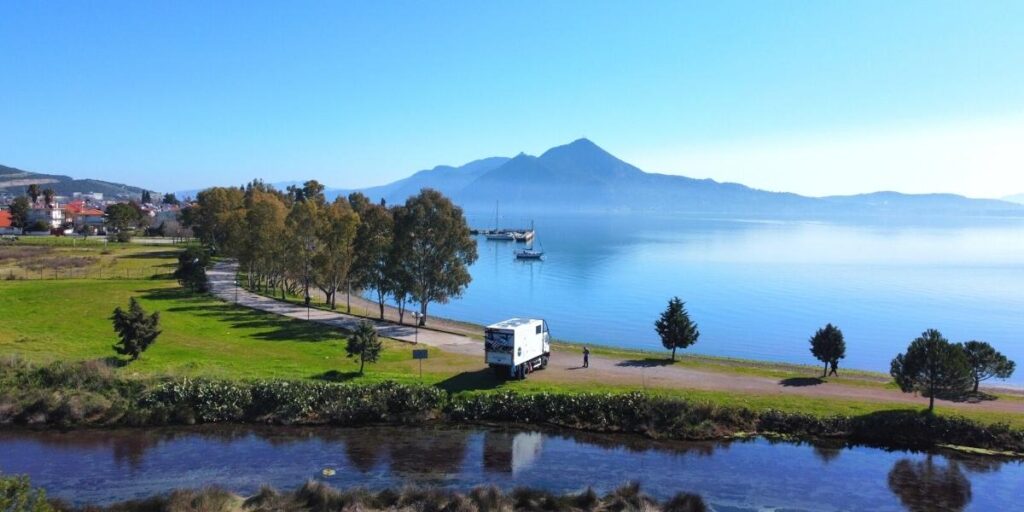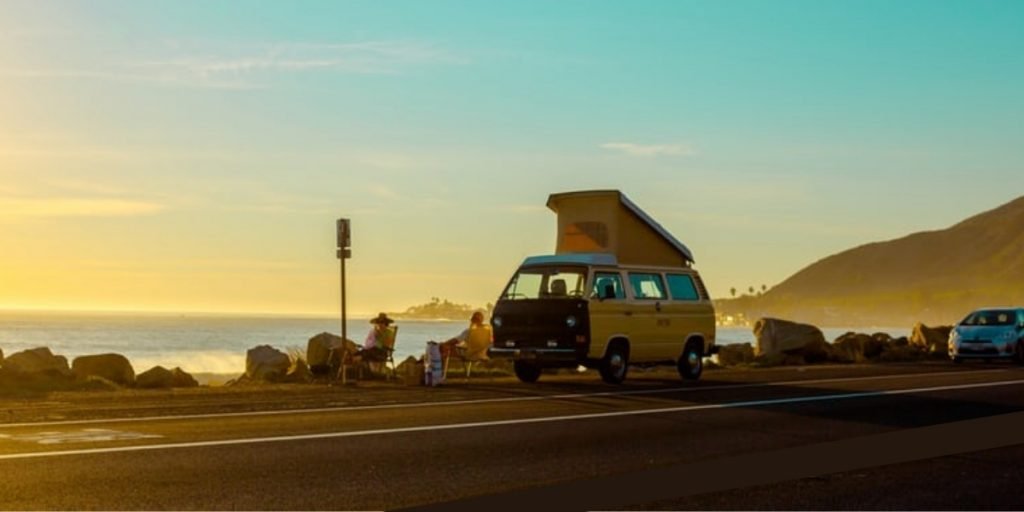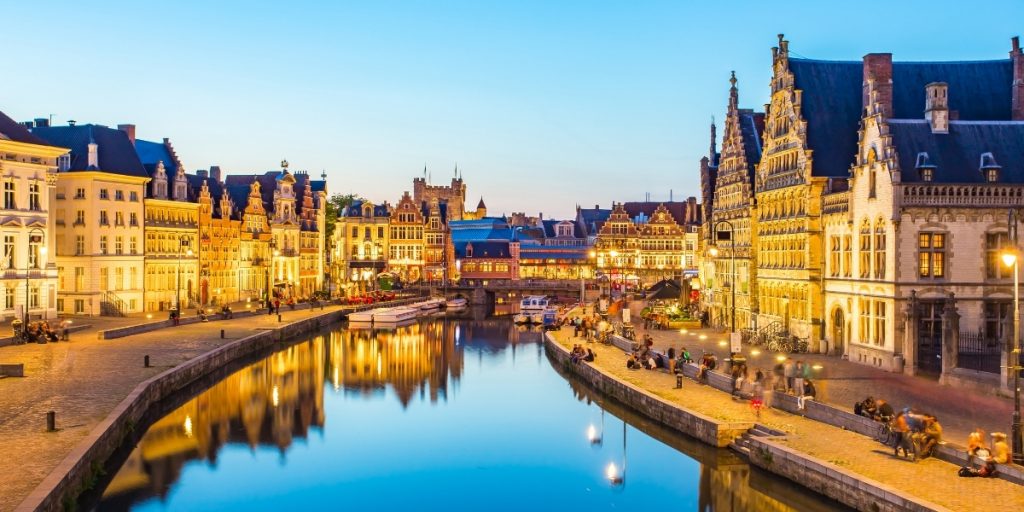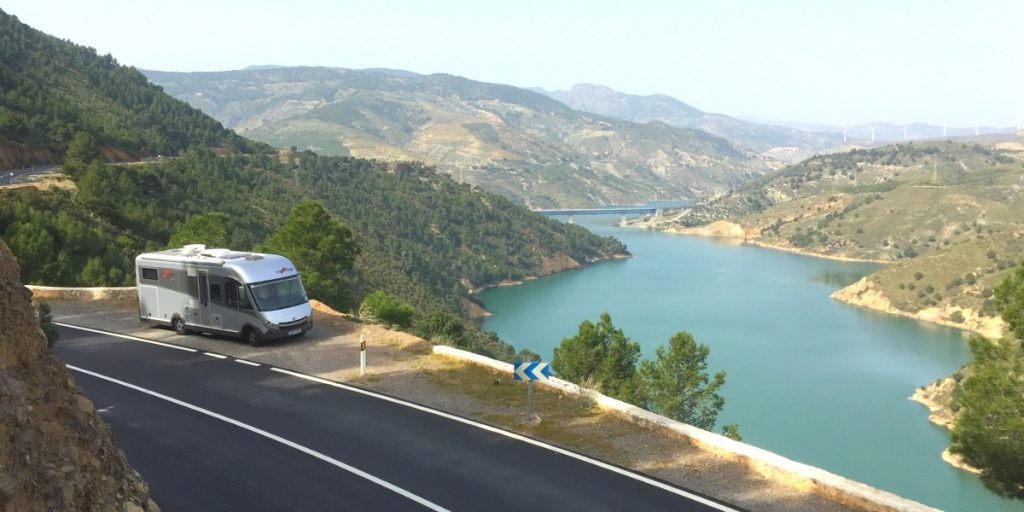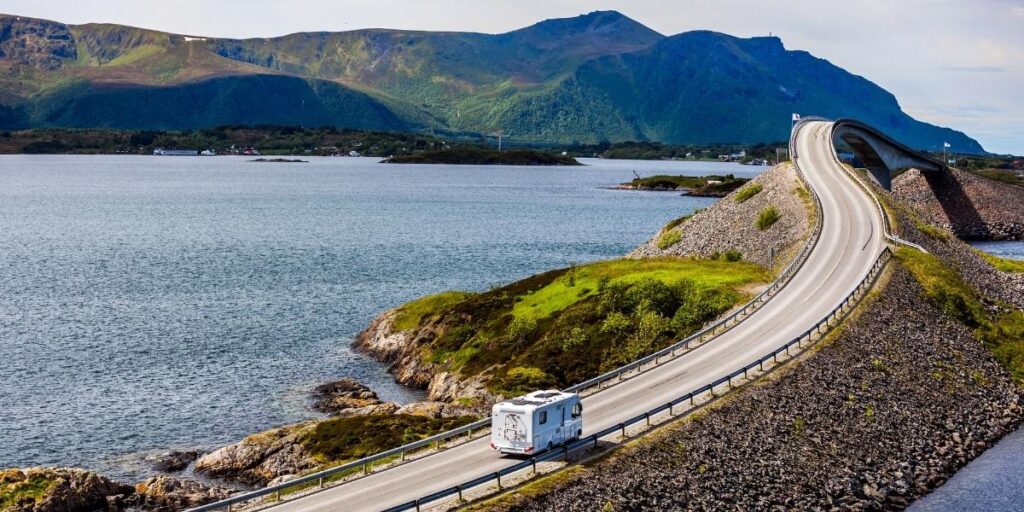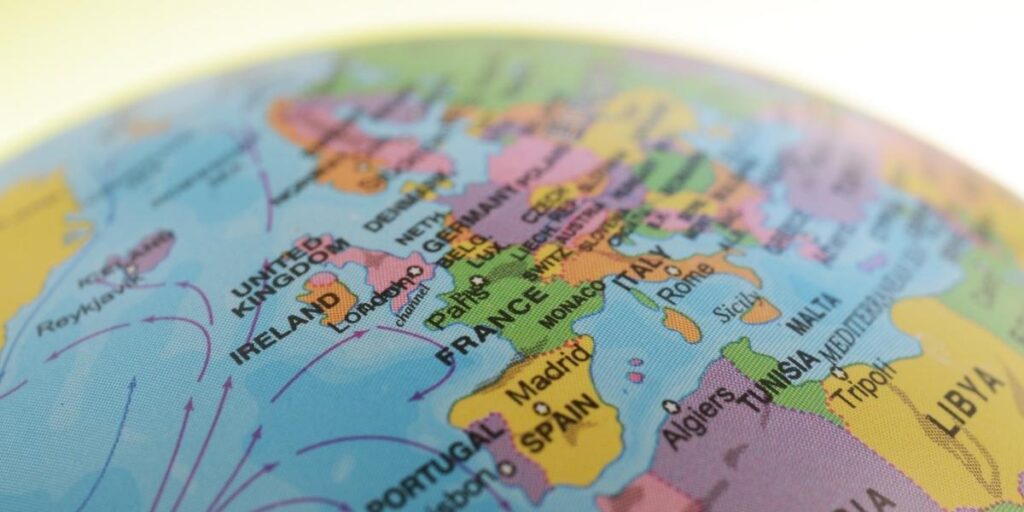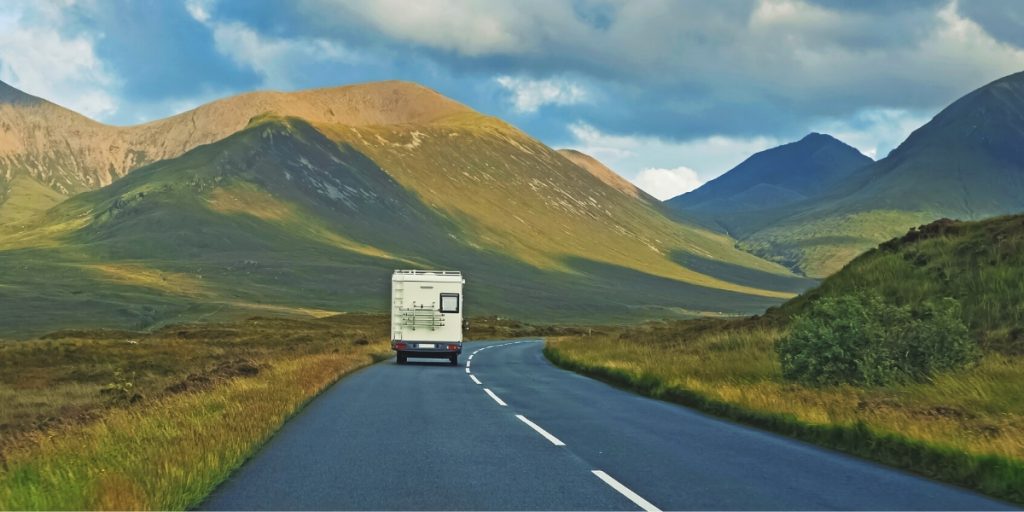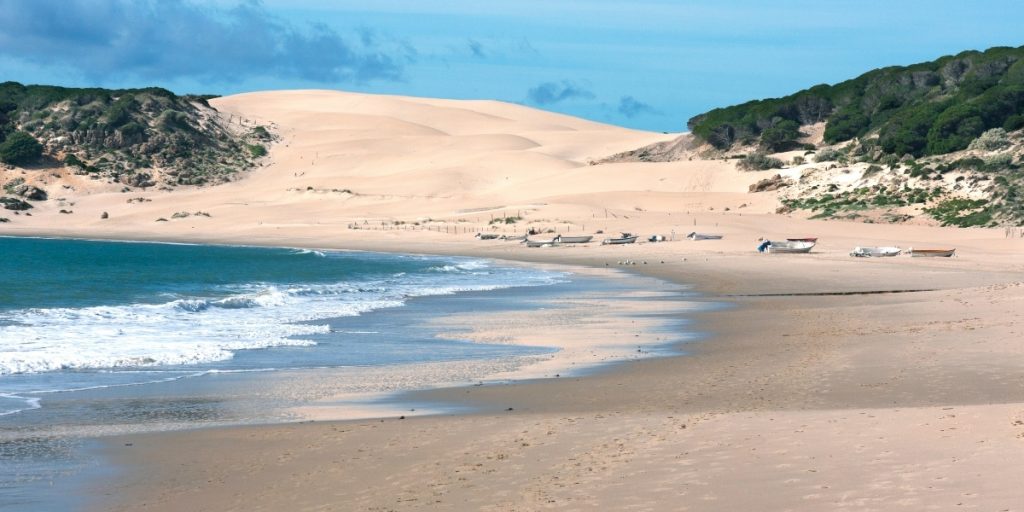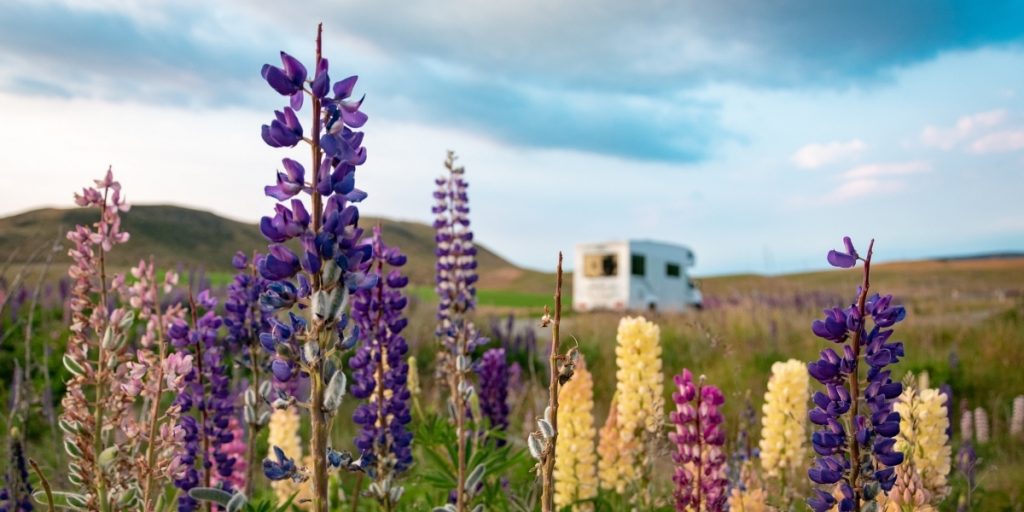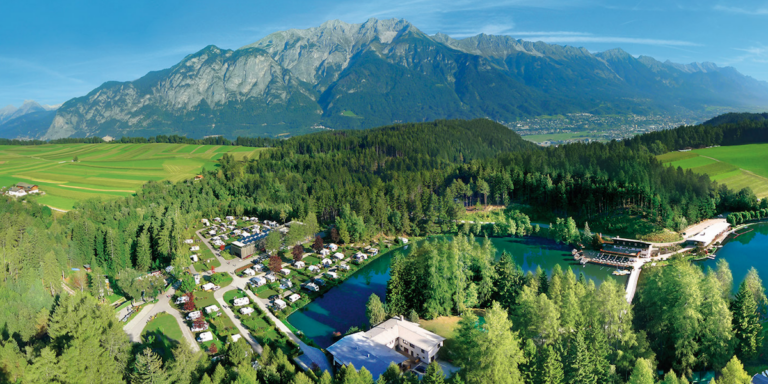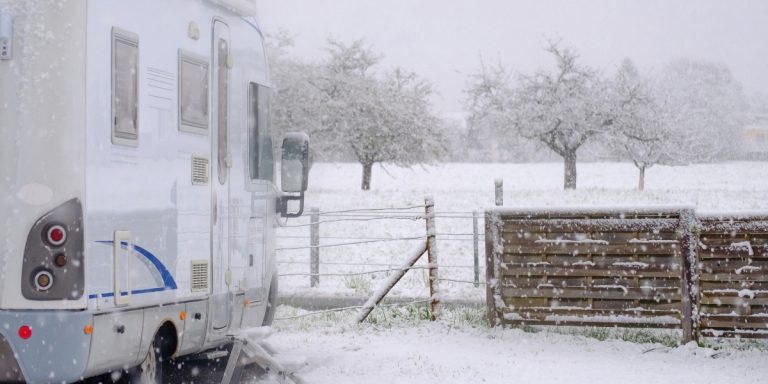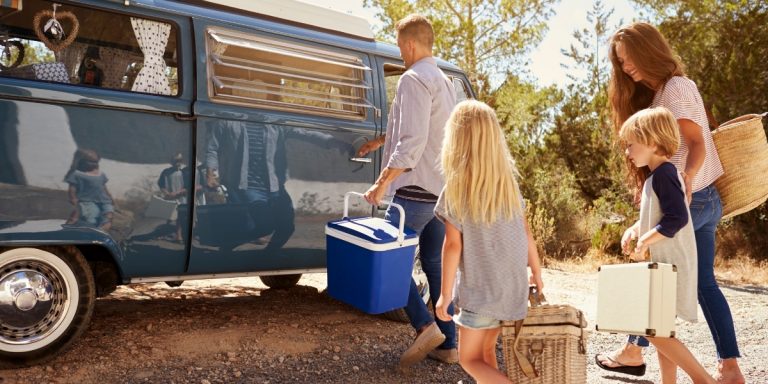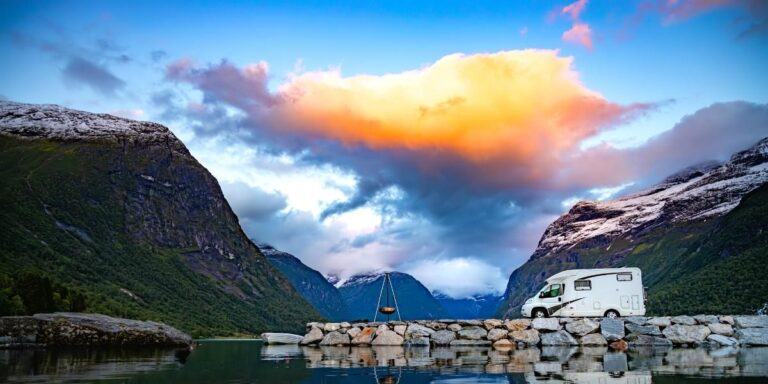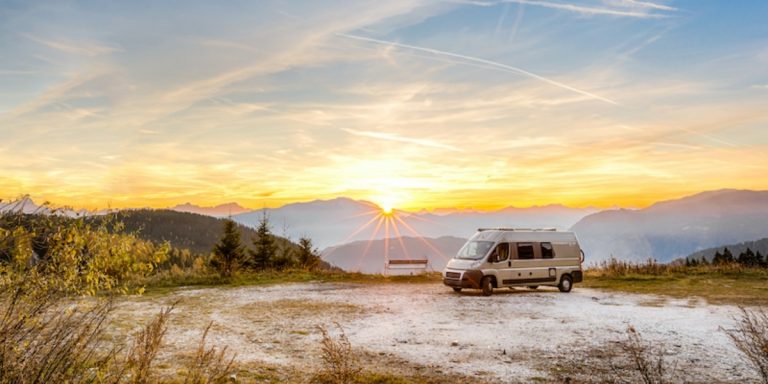This post may contain affiliate links, from which we earn an income.
Complete motorhoming guide for beginners
So, you’ve decided to buy a motorhome… great decision! You’ve joined a growing family of new motorhome owners who love the freedom of motorhoming. The ability to get away spontaneously and change your mind halfway there is priceless, but you probably already know that!
When we started motorhoming, we knew nothing! Being a first-time motorhomer was daunting and finding information was difficult. But, we’ve been living on the road for over five years and have picked up a bit of knowledge along the way!
We’re sharing our top tips about motorhoming for beginners so you can learn how to motorhome with confidence. This comprehensive guide includes information for new motorhome owners, practical motorhome advice and easy guides, top motorhoming travel tips and free downloadable checklists to get you motorhoming like a pro!
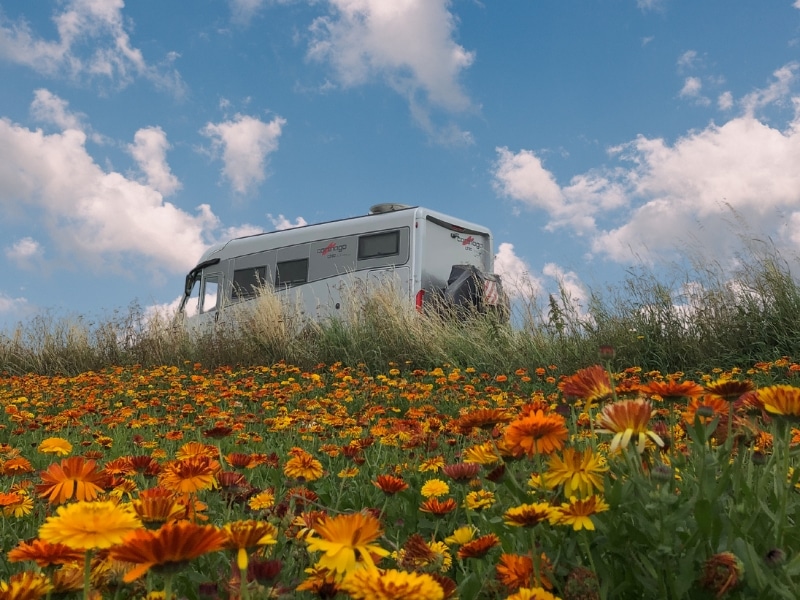
Buying a Motorhome
Finding the Right Motorhome
From huge A classes to small 6.5 metre motorhomes, there are hundreds of different types and models of used and new motorhomes available and thousands on the market at any given time.
If you’re completely new to motorhoming, deciding whether you want a motorhome or camper van, and what you want in your recreational vehicle can take a little while. Over 75% of motorhomers say they don’t get it right the first time. That’s quite a lot of people, including us!
The first motorhome we bought was gorgeous but a bit too fancy and we worried about it being damaged, especially as we wanted to go to off-the-beaten-path places in Morocco and Turkey. We downgraded to a similar layout but older, with a few more miles and were happy with that for a few years before we decided we wanted an overland truck!
A truck works for us because we like to travel to remote areas and stay off grid. And that’s the whole point – whatever you buy has got to work for you. Size, weight, number of passenger seats and berths, off-grid capacity, layout and running costs all need to be considered before purchase.
It’s a good idea to rent a motorhome for a week or two to see if you enjoy the lifestyle (someone in our Facebook group did this and decided motorhoming wasn’t for them, just before dropping £50k on a used motorhome!) and to help you make an informed decision.
If you rent, you can also see how the layout works for you and what might work better. For some people the type of bed is really important, for others it’s all about socialising and creating extra room with a pull-down bed or having enough room in the garage for a scooter.
Although not a substitute for being in an actual motorhome, reading motorhome magazines and watching shows like Million Pound Motorhomes and Motorhoming with Paul Merton and Suki Webster is also a good way to see inside a variety of vans and get an idea of what life on the road can be like.
TOP TIP: The best way to find out what’s available is to head to one of the Out & About Live shows where you will be able to check out manufacturers, new models, and the design and build quality of the various brands and manufacturers, and see their best deals. Another great place to check out layouts, designs and manufacturers is at a local motorhome dealership, where you can have a look around their stock.
How to Buy a Motorhome Safely
If you’re buying a second-hand motorhome or camper from eBay (a good place to look for used vans) or any other online marketplace, be sure that you understand how scams work before parting with any cash.
We have safely bought (and sold) four vans via eBay and it’s a great way to find your perfect motorhome, just be aware that not every advert on this type of platform will be legitimate.
TOP TIP: Never, ever pay for a motorhome or place a deposit until you have viewed and are 100% happy, whether that’s from a dealer or private seller. It sounds obvious, but people get caught out all the time.
Habitation & Damp Checks
Make sure you get a habitation and damp check done independently, this will assure you that everything in the habitation area of the motorhome works and that you won’t have to pay what can be huge sums of money to have damp repaired. It’s important you have this done independently, as checks can be falsified.
A motorhome damp and habitation check will cost somewhere in the region of £250 depending on where you are in the country. The extra cost will be the best money you spend in your search for the perfect second-hand motorhome.
RELATED POST: Motorhome Habitation Checks – All You Need to Know
Buying From a Dealer
If you’re buying a used motorhome from a dealer, be aware that not all motorhome dealers are created equal! Some have dreadful reputations; again Facebook is a great source of information so check out your dealer on some of the forums.
If you’re buying your motorhome using hire purchase offered by the dealer, make sure the product is regulated by the Financial Conduct Authority.
Try to get a warranty included in the deal if at all possible. This will give you some comeback if anything goes wrong.
TOP TIP: If you’re buying a new or used motorhome from a dealer, use a credit card to pay for the deposit or part of the deposit. This will ensure you are covered under Section 75 of the Consumer Credit Act in case of the dealer going bankrupt, or there being a problem with your motorhome. This does not apply to used motorhomes using Paypal, which invalidates the Section 75 protection.
Buying Privately
If you are buying your motorhome privately, make sure you are happy that the seller is genuine, particularly if you are using eBay or another auction type site. If it’s too good to be true, it probably is!
TOP TIP: Get an HPI check done on the motorhome to make sure it’s finance-free and hasn’t been written off.
What to Look For When You View
If you’re new to motorhomes the best thing is to get someone with some motorhome knowledge to go with you to view. You may want to check all the systems, such as heating, solar charge, hot water and so on do actually work, that windows open and close and blinds are operational. Although a good habitation check will also cover motorhome systems, they may miss smaller things.
You should also arrange for the engine part of the motorhome to be inspected or checked over by a mechanic if there is no, or only limited, service history.
Use our buying a used motorhome checklist to help you on the day you view. It’s got a comprehensive list of everything you should be looking at and a handy reminder of the important points above.
RELATED POST: Buying a Motorhome That’s Right for You – All You Need to Know
Collecting Your New Motorhome
When you collect your new motorhome, make sure you get a thorough handover from the dealer or private seller.
Understand how the systems work, what switch does what, where you fill your fresh water tank and how you empty waste, how the control panel(s) work, where the spare wheel and locking wheel nut are and where to locate the fuses.
The Complete Guide for Motorhome Beginners
With our best motorhome tips and advice about motorhome basics to where to park for the night and ideas for touring Europe, this is the ultimate resource for motorhome newbies.
This motorhoming ebook will help you get to grips with the inner workings of your motorhome, giving you confidence for life on the road and your first motorhome adventure!
Other Things to Consider Before Purchase
What Kind of Driving Licence Do I Need?
It may sound obvious, but we recently supported a motorhome owner who had bought a used motorhome but didn’t have the licence requirements to drive it as it was over 3,500kg, and they hadn’t done any research before buying.
Motorhomes are usually banded into three categories by manufacturers and it’s mostly to do with how driving licence groups dictate what you can drive:
Motorhome Weights
All motorhomes have a MAM (maximum authorised mass), also known as GVW (gross vehicle weight). This weight is shown on the weight plate, usually found inside the door of the motorhome. This weight is the heaviest your motorhome can be when fully laden and if you exceed this, even with a little extra weight, you are breaking the law and will also invalidate your insurance.
All motorhomes also have an MRO or MIRO (mass in running order), which is the weight of the new motorhome as it leaves the factory. There is no legislation that dictates what this should include but it is usually made up of a 50% full fuel tank and a driver who weighs 75kg, a full fresh water tank and a full gas bottle.
The payload of motorhomes is the difference between how much your motorhome weighs when it leaves the factory (the MRO) and the gross vehicle weight. These weight limits are important because your payload dictates how much water, gas, people, personal items, food and accessories you can carry.
It may be difficult to find the mass in running order weight for a used motorhome or converted van. If this is the case, you can check with the manufacturer or ask the dealer to take it to a weighbridge and get a stamped ticket to evidence the empty weight.
Even though it won’t be the manufacturer’s mass in running order weight, it’s a straightforward process to work out the payload – just deduct the weighbridge weight from the gross vehicle weight and that’s your payload.
TOP TIP: Some motorhomes have impossibly small payload limits, especially if you’re a large family, so make sure to do your own homework and remember, buyer beware.
RELATED POST: An Easy Motorhome Weight Guide
Storing Your Motorhome
Think about where you will store your motorhome when you’re not using it. What are its dimensions? Will a larger vehicle fit on your drive?
You may also want to consider secure motorhome storage, which is an added cost, but means you are extremely unlikely to be a victim of motorhome theft. In fact, more motorhomes are stolen from driveways than anywhere else.
Wherever you store it when not in use, you should consider security options including alarms, trackers, immobilisers and physical security and there’s a good chance that your motorhome insurance company will insist on some of these measures. This is a good article from the Camping & Caravanning Club about motorhome security.
RELATED POST: Motorhome Storage – Your Complete Guide
Motorhome Insurance
You’ll need specialist motorhome insurance. Depending on the value, your insurer may require you to fit an alarm and/or tracker (usually the type that connects to a 24/7 monitoring centre). This can be expensive, so check likely costs with an insurance broker before you sign on the dotted line.
If you’re planning to live full time in a motorhome and won’t have a bricks-and-mortar property to return to, then you will need full-timing insurance, a specialist product.
RELATED POST: The Essential Guide to Full-Timing Motorhome Insurance
Getting Around
Getting around with a motorhome is easy, but what about when you’re on a campsite, want to stay stationary for a few days or spend one day in a city you just can’t drive by?
Some people tow a small car or carry a scooter, but most carry electric bikes or bikes. This is an added cost and you’ll need a bike rack too, so it’s worth adding into the equation when buying a motorhome.
RELATED POST: The Best Motorhome Bike Racks & Bikes
What Motorhome Accessories Do You Need?
Motorhome purchased and sitting happily on your drive (or in secure storage!), now what? Well, you need to kit it out; some of that will be what you already use at home but you will need some specialist motorhome accessories too.
Packing a Motorhome
If you’re wondering how to pack a motorhome, a lot of it is common sense. Heavy stuff should go in low cupboards or outside storage space, and lighter stuff should be in overhead cupboards but secured or compartmentalised in boxes to reduce movement. Try and spread your stuff around so you have equal storage side to side and front to back.
TOP TIP: Felt boxes make for great storage as they won’t damage the inside of your cupboards, reduce rattling and help keep stuff safe.
RELATED POST: Storage Ideas for Campervans You Need to Know About!
Motorhome Accessories Buying Guides
You don’t need lots of specialist motorhome kit when you first start. Work out how you want to motorhome and where you’re going to travel before spending a lot of money.
The list of the things you need for your first trip is short: an orange hook-up electric cable; a food grade hose pipe for filling fresh water; some unbreakable plates and cups, a gas kettle and toilet chemicals. You might want levelling chocks and some awning hold-down staps too, and perhaps a collapsing bucket or washing up bowl. Otherwise, you can take pots, pans and bedding from home.
Getting Weighed
Once packed, and before your first trip, head off to the weighbridge with a half tank full of water and fuel, your gas bottles full and tyre pressures correct.
Once packed, and before your first trip, head off to the weighbridge with a half tank full of water and fuel, your gas bottles full and tyre pressures correct.
Get weighed and make sure you’re within your van’s weight allowance. If you’re overweight or at the top of the weight limit, you may want to think about travelling with an empty water tank and doing the food shop when you get to your destination – every little compromise helps manage any additional weight.
RELATED POST: 16 Tips to Help Manage Your Motorhome Payload
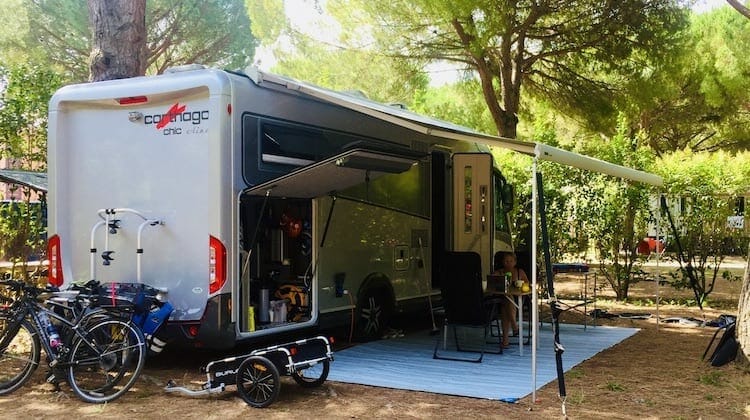
Motorhoming Tips
Driving a Motorhome
Driving a large vehicle like a motorhome for the first time is a new challenge and can seem daunting due to its size and mechanics, especially if you’ve only ever driven a car before.
The size and weight of even a small motorhome make a big difference that can significantly impact the steering, braking, and overall manoeuvrability. This, together with many more blind spots than a car, requires a heightened sense of awareness.
The driver must always consider the vehicle’s dimensions, especially the overall length, height and width, which play a critical role in determining the feasibility of passing through routes with narrow roads, low bridges, or tunnels. Factors like wind resistance and vehicle stability in different weather conditions also add layers to the driving experience.
In the UK, motorhomes also have different speed limits for trucks, vans and cars, but only if they are registered as a motor caravan on the V5 log book. In terms of speed limits, motorhomes are split into two categories: more than 3.05 tonnes (that’s not an error!) and less than 3.05 tonnes of unladen weight.
TOP TIP: If you are driving a motorhome or campervan for the first time, both the Camping and Caravanning Club and the Caravan and Motorhome Club offer courses on manoeuvring a motorhome with confidence.
Your First Motorhome Trip
Have a bit of a shakedown before heading off on your first adventure. Whether this means a quick weekend camping trip, a proper motorhome holiday or a few nights on your drive in the motorhome, you will be thankful you did.
Motorhomes are complex bits of kit, especially if you have newer technology. It can take a bit of time and trial and error to understand how your motorhome is set up and how everything in your van works together.
Spend the time now and you will head off on your first motorhome trip knowing your van, and with everything you need to kick back, relax and have an amazing time.
Before your first drive, make sure you know your motorhome dimensions, especially the height. Write them down somewhere so that you can easily see them when driving. This helps if you see a sign for a narrow road or low bridge for example – you can quickly refer to your note to ensure you have enough clearance. Alternatively, get a motorhome sat nav!
TOP TIP #1: Make sure you fit or take from home a fire extinguisher and a carbon monoxide detector. It’s best to be cautious where gas appliances are concerned, especially if your motorhome is a bit elderly and you have not used it before.
TOP TIP #2: Download our printable free motorhome departure checklist to make sure your motorhome is safe and secure to drive before you set off.
RELATED POST: How to Take Your First Motorhome Trip
Motorhome Services
Whether you stay on a campsite, utilise an aire (a designated motorhome parking area), wild camp or park by the side of the road, you’ll need to manage all your water and waste. Use an app like Park4Night to find services for your motorhome or look for the blue and white dump station signs.
Grey Waste
Grey waste refers to all your used water other than toilet waste, so anything from your washing up bowl, sinks, shower and washing machine, if you have one.
Some motorhomes will have an indicator on the control panel to let you know how full your waste tank is. It makes sense to empty whenever you fill up, which is why motorhome service points are so handy.
Most grey waste disposal points consist of a drive-over area with a large grating. Where this is not the case, there will be a hole which you should try and position your waste outlet over. if your grey waste has spilt over the hole or grating, it’s good practice to wash the area down with the (usually) provided hose.
If you’re on a campsite for more than a few days, you’ll want to empty your grey waste tank but won’t want to take your motorhome to the service station. There may be a soil pipe on your pitch, but these can be fiddly to use because there is not enough fall from your motorhome or the pipework is not standard. We tend to leave a bucket under the outlet pipe and dispose of the waste manually on a regular basis.
TOP TIP: Open your waste tank valve slowly until the flow starts, then you can open the valve all the way. If you open the valve fully at the start, you will get splashed!
Black Waste
Black waste, or black water, is your toilet waste, and if you have a cassette toilet, you need an Elsan or chemical toilet disposal point. In our experience, black waste points come in many forms and are not all equal! We’ve used everything from a shiny purpose-built service area with automatic flushing and public toilets (in an emergency) to literally an open sewer in the ground.
This great YouTube video from Thetford shows you how to empty your toilet cassette – a necessary part of van life! Your’s may look slightly different but most modern motorhomes have cassette loos that work in the same way.
TOP TIP: If you have the type of toilet that has a light to let you know when to empty, always empty when the light comes on. We learned this early on when we left it a bit late and had a very messy experience with an overflowing cassette!
RELATED POST: On-the-Go Convenience: An Easy Motorhome Toilets Guide
Fresh Water
When we first started motorhoming, it came as a shock to find how much water we used and wasted. The average adult uses 110 litres of water a day and the average motorhome fresh water tank is around 100 litres.
This means really thinking about how you use water and how you can conserve it, or you’ll be filling up twice a day!
Again, all campsites, aires and some garages will have a drinking water tap, and on some sites, this will be on your pitch (if not carry a large watering can). We always use our own hose as you don’t know where the provided one has been. If you really have to use another hose, wipe it with disinfectant first.
What to Do If Something Goes Wrong
Motorhomes are complex vehicles and things do sometimes go wrong. That’s why you need to have this first trip so that if something does happen, you can get home and get technical help before you go further afield. Take the following steps before ringing the dealership or motorhome workshop:
Security
Although security issues are rare, keeping yourself safe when you’re travelling in a motorhome will help you enjoy a great trip, especially if you’re planning on motorhome wild camping.
Lots of personal safety tips are common sense, but there are also lots of physical security measures you can take to ensure your van is stolen or broken into, such as alarms and steering wheel locks.
RELATED POST: Staying Safe & Legal in Your Motorhome
Travel Insurance
Make sure that you have good travel insurance should the worst happen. We always recommend True Traveller, which we use ourselves. As well as short-term cover, they also offer backpackers cover if you’re planning a longer trip.
Motorhome Breakdown Cover
You may decide to take out breakdown insurance, especially if you have an older motorhome. Check that the motorhome breakdown service is valid for the length, weight and age of your motorhome. Some policies offered as part of a packaged bank account or included with insurance have limitations.
TOP TIP: The best breakdown insurance we have found that doesn’t have any limitations and will also cover Europe is RAC Arrival.
Vehicle Safety Equipment
There are also things you must carry with you in your motorhome every time you set off on a trip, to keep you and your vehicle safe (and legal!).
Unlike the UK, most countries have a specific list of equipment you must carry, which usually include a warning triangle, reflective jackets, spare tyre and a first aid kit. If you’re heading for Europe, you can find all this useful information in our country-specific touring guides.
Documentation
If you’re motorhoming in the UK (and you’re British) you don’t need to carry any documentation with you. Overseas visitors should carry a passport and vehicle documentation.
In Europe, the important things you must carry are your passport with at least 3 months remaining, a valid driving licence, the V5 vehicle registration document, the MOT certificate and motorhome insurance (a green card is no longer required for countries in Europe that belong to the European Union).
Motorhome User Manual
Take time to work through the motorhome instruction manual. If you don’t have one look online, or contact the motorhome manufacturer or the dealer. Failing that, see who else has your make and model on Facebook and make contact. That quirky little red switch under the fridge might suddenly make sense!
TOP TIP: Make sure to take your manual with you on your first motor home road trip so that you have something to refer to if you have a problem when away.
Frequently Asked Beginners Questions
If you frequent Facebook or online motorhome forums, you’ll notice the same questions cropping up again and again. We wrote a post which you can refer to if you’ve got a problem that you’re unsure about or can’t solve. Usually, it’s straightforward, but none of us is born knowing about motorhoming!
RELATED POST: Motorhoming Made Easy: Your Top 20 Questions Answered
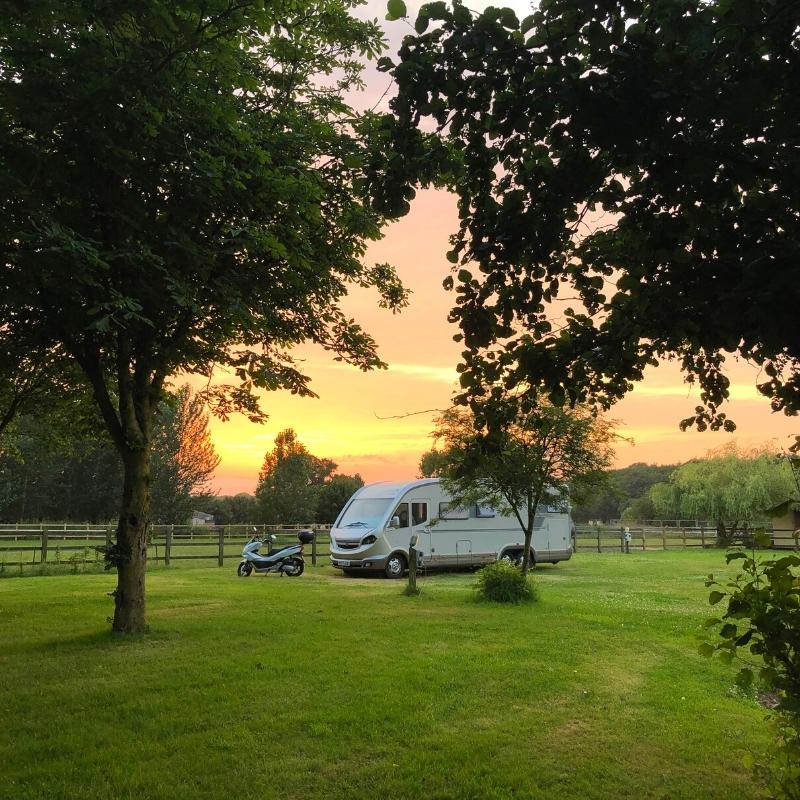
Understanding Motorhome Systems
Electrics & Solar
What do you need battery power for… and what’s a leisure battery anyway? How do solar panels work? Do I need an inverter? Can I use an electric kettle or a hairdryer? When do you need mains hook-up and what even is that?
One of the questions we get asked most is “why don’t my sockets work?”. Usually, the person asking is referring to regular three pin sockets like you get at home. If you have these sockets, they will only work if you are connected to a power source by electric hook-up, or you have an inverter fitted, which transforms 12 volt electricity in 230v electricity.
All motorhomes, regardless of whether they are fitted with 230v sockets, will have a 12v system too. This system is used to run the 12v sockets, lights, water pump, cooker ignition, satellite system, electric step and any other factory-fitted electrical equipment.
TOP TIP: Always fully uncoil your EHU (electric hook up) cable when you plug in. Leaving them coiled can lead to overheating and potentially cause a fire.
RELATED POST: An Easy Guide to Motorhome Electrics
Motorhome Gas
Gas is an incredibly versatile fuel and can be used to heat your hot water system, fuel your motorhome heating system, cool your fridge and provide fuel for your cooker or oven.
There are a number of different ways of supplying gas to your van including traditional bottles, an underlung LPG tank, removable gas bottles which can be filled at the pump and refillable systems like Gaslow.
RELATED POST: An Easy Guide to Motorhome Gas & LPG
Fresh Water Systems
Your motorhome will be fitted with an onboard fresh water tank, hidden somewhere underneath. You’ll probably have a sensor somewhere in the habitation area which tells you how much water is in the tank. Some people choose not to drink water from their tank and carry bottled water, and others have a filter system fitted to get rid of any nasties.
You’ll also need to give your tank and water pipes a good clean from time to time, to stop smells building up (all that lovely floral stuff you put down the sink really smells when it breaks down in your tank) and to keep your systems safe to use.
TOP TIP: Whether you drink the water or not, we advise the regular use of water purifying tablets to prevent your tank from becoming contaminated.
RELATED POST: An Easy Guide to Motorhome Water Systems
Motorhome Internet & TV
Some people want to head off and leave all their devices behind, but we love to be able to research, post on social media, run this motorhome and road trip blog and watch TV.
There are lots of different ways to get internet in the UK and Europe, from fitted WiFi devices and hotspotting or thethering from your phone to satellite internet like Starlink. It seems confusing, but once you understand the options, it’s relatively straightforward.
Ongoing Maintenance
There is lots of things you can do to keep your motorhome ticking over and in good running order.
Regular Servicing
It goes without saying that the engine element of your van needs looking after. The annual MOT and regular servicing will give you peace of mind, especially if you’re heading to Europe and beyond.
Cleaning Your Motorhome
When you live and travel in a motorhome, it gets dirty, just like your house. With a motorhome, there are areas which need special attention and care to keep them clean, from the acrylic habitation windows to the solar panels on the roof and everything in between.
RELATED POST: Motorhome Cleaning – The Best Methods & Products
Preventing Condensation
The bane of motorhomers lives, condensation is almost impossible to fully eradicate, especially in winter.
Created when hot air inside meets cold air on external surfaces, like windows, condensation makes your motorhome feel damp and cold. A well-built motorhome with no leaks and plenty of ventilation is key to prevention.
RELATED POST: How to Stop Condensation in a Campervan
Diagnosing Smells
When you live in a small tin box, anything smelly becomes noticeable pretty quickly. Working out whether the smell is socks or something more sinister is easy when you know how!
RELATED POST: Help …My Camper Smells Bad
Laying Up
If you don’t use your motorhome all year round, you’ll need to take steps to ensure your van stays in tip-top condition for your next trip.
RELATED POST: Motorhome Storage – Your Complete Guide
Planning a Motorhome Road Trip
Motorhome Destinations
Your motorhome is bought and kitted out, and you’ve spent a weekend working out motorhome etiquette, how to boil the kettle, empty the toilet cassette, make your bed and keep your paintwork clean – you’re ready for your first motorhome holiday!
Where are you going? Well, that depends really on how long you have, how many miles you want to drive, what you want to spend and what sort of places you like to visit.
You could be planning a six-month tour of the warmer parts of Europe, a two-week road trip in Scotland doing the North Coast 500, a month hiking the national parks of Europe, or Christmas in Spain… that is totally the beauty of motorhoming!
Our country-specific motorhome touring guides have a wealth of current information about driving, motorhome camping, services, practical tips and destinations for many European countries and the United Kingdom.
Motorhome Travel & Road Trip Resources
We’ve also got a lot of trip tips, motorhome camping hacks, inspirational motorhome book ideas and information on how to help you organise your perfect trip.
We love the great outdoors and wild camping in our motorhome – who doesn’t love a spot of free motorhome overnight parking? – but also enjoy chilling at great motorhome campsites when we need a bit of downtime, or to do some washing!
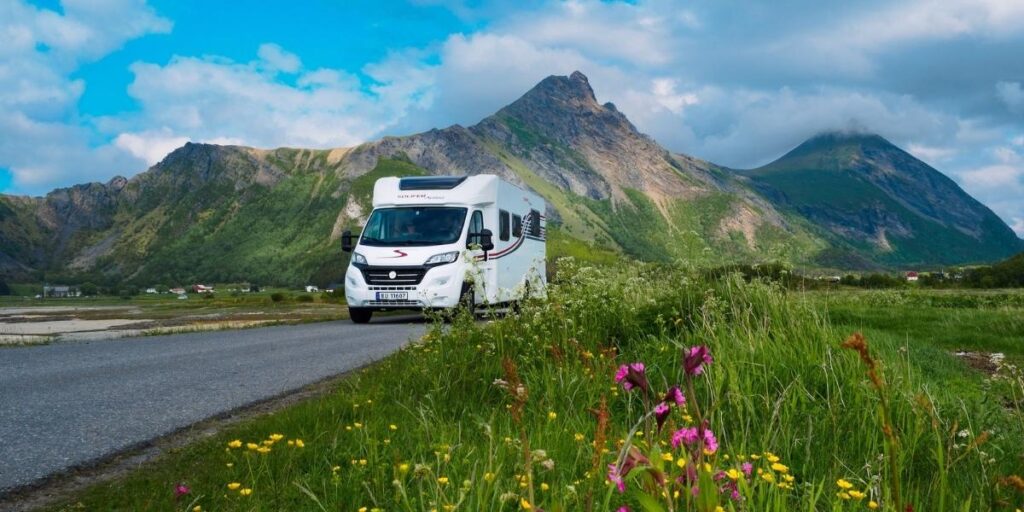
Last Thing… Chat With Us!
We love answering questions! If you need motorhome help, more information or something is not clear, please drop us an email and we’ll get back to you as soon as we can!
That’s it folks, that’s all our top motorhome and campervan tips and tricks for the UK and abroad! Enjoy your motorhome or campervan, wherever and however you decide to travel. We think travelling by motorhome is the best way to see the incredible world we live in. We hope you feel the same way too!
Looking for more top motorhome tips? Check out these top posts…
ACSI Camping Card – 2024 Review & Step-by-Step Guide
What Is the True Cost of Touring Europe in a Motorhome?
Winter in a Motorhome – Tips, Tricks & Essentials
20 Amazingly Simple Camper Hacks
Motorhome Glossary: A-Z of Terms & What They Mean
Fifteen Awesome Reasons to Choose Motorhome Life
Love it? Pin it!
